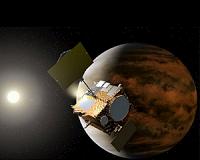 |
Tokyo (AFP) May 18, 2010 Japan on Tuesday postponed the launch of a rocket due to deploy a Venus probe and an experimental "space yacht" propelled by solar particles, because of bad weather at the launch site. The Japan Aerospace Exploration Agency (JAXA) decided on the delay six minutes before the scheduled launch of the H-IIA rocket, set for 6:44 am (2144 GMT Monday), as weather worsened at the Tanegashima space centre in southern Japan. "There is a risk of thunderstorms," a JAXA official said. The rocket was to blast off with "space yacht" Ikaros -- an acronym for Interplanetary Kite-craft Accelerated by Radiation of the Sun -- which is propelled by the pressure of sunlight particles bouncing off its sail. JAXA rescheduled the launch for 6:58 am Friday (2158 GMT Thursday). Ikaros, which has cost 1.5 billion yen (16 million dollars) to develop, will be the first use of the technology in deep space. Past experiments have been limited to unfolding its sail in orbit around the Earth. The flexible sail, thinner than a human hair, is also equipped with a thin film of solar cells to generate electricity to create "a hybrid technology of electricity and pressure", according to JAXA. The technology could enable space travel without fuel as long as there is sunlight, its developers say. The name of the spacecraft alludes to Icarus, the figure from Greek mythology who flew too close to the sun and fell into the sea. The same rocket was also due to launch Japan's first satellite bound for Venus, called the Akatsuki, or PLANET-C, which will work closely with Venus Express, a satellite sent earlier by the European Space Agency.
Share This Article With Planet Earth
Related Links Venus Express News and Venusian Science
 e2v Imaging Sensors To Study The Planet Venus On JAXA's Venus Climate Orbiter
e2v Imaging Sensors To Study The Planet Venus On JAXA's Venus Climate OrbiterChelmsford, UK (SPX) May 18, 2010 On 17th May 2010, e2v Charge Coupled Device (CCD) imaging sensors are due to be launched into space on board the Japan Aerospace Exploration Agency's (JAXA) Venus Climate Orbiter "Akatsuki" (formally known as PLANET-C) to study the planet Venus. e2v CCD47-20 sensors equip the spacecraft's Ultraviolet Imager (UVI). Akatsuki will use infrared light to make a detailed investigation of Venus, ... read more |
|
| The content herein, unless otherwise known to be public domain, are Copyright 1995-2010 - SpaceDaily. AFP and UPI Wire Stories are copyright Agence France-Presse and United Press International. ESA Portal Reports are copyright European Space Agency. All NASA sourced material is public domain. Additional copyrights may apply in whole or part to other bona fide parties. Advertising does not imply endorsement,agreement or approval of any opinions, statements or information provided by SpaceDaily on any Web page published or hosted by SpaceDaily. Privacy Statement |